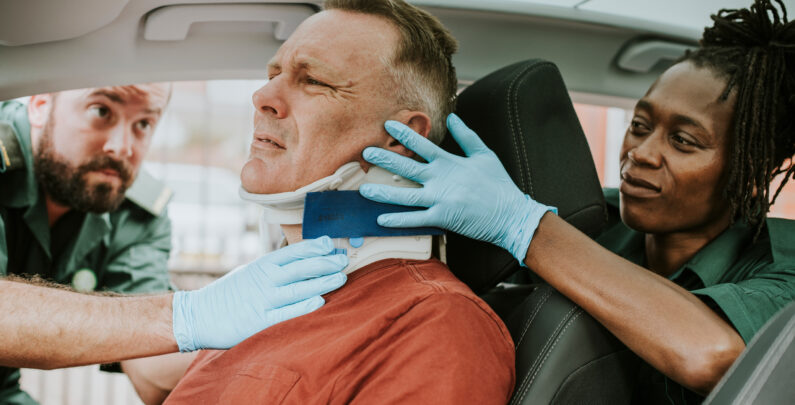Recent News
What Fractures Happen Most in Car Crashes?
After a car crash, it is difficult to know if the soreness you feel is just a temporary ache or something more serious. The rush of adrenaline can hide significant pain, making it easy to overlook injuries. Fractures are among the most common and easily missed injuries following an accident. At Brassfield & Krueger, we have worked with injury victims for over 75 years and have seen how frequently certain fractures go unnoticed right away. Some of the most common fractures you need to be on the lookout for after a car crash are:
- Wrist and Arm Fractures
- Clavicle (Collarbone) Fractures
- Rib Fractures
- Leg and Femur Fractures
- Spinal or Vertebral Fractures
Understanding how and why these fractures occur can help you recognize symptoms early, seek prompt treatment, and protect your right to compensation.
What Exactly Is a Fracture?
A fracture is simply a break, crack, or severe stress in a bone. Even small “hairline” fractures can cause serious pain and lead to long-term problems if not properly treated. In a car crash, high-impact forces, seatbelt tension, airbag deployment, or compression can all cause bones to break. Knowing what a fracture is helps you understand the warning signs.
What Are the Signs That a Bone Might Be Broken After a Car Accident?
You may have a broken bone if you experience intense, localized pain that gets worse with movement. Here’s what to watch for in the hours or days after a crash:
- Swelling, bruising, or a visible deformity in the affected area
- Inability to put weight on a limb or use it normally
- Numbness or tingling, which might suggest nerve involvement
Sometimes, a fracture does not cause extreme pain immediately, especially in smaller bones or when you are in shock. It is always best to get checked by a doctor after a crash, since even minor accidents can hide serious injuries.
How Do Different Car Crashes Lead to Different Types of Fractures?
The type of fracture you suffer often depends on how the collision occurred and where your body absorbed the impact. A rear-end collision can cause your upper body to whip forward, leading to spinal compression fractures or breaks in the neck and collarbone. Side-impact crashes often twist the torso and legs, resulting in hip or femur fractures. Head-on collisions can cause severe leg and arm fractures as the body braces against the dashboard or steering wheel. Even low-speed crashes can lead to wrist or rib fractures from bracing or seatbelt tension. Understanding how fractures occur can help doctors identify hidden injuries and build a clearer record for your personal injury claim.
How Serious Are Different Types of Fractures?
Not all fractures are the same. Doctors classify fractures by severity, which determines how your treatment and your compensation will look.
- Simple (Closed) Fractures: The bone breaks, but the skin remains intact.
- Compound (Open) Fractures: The broken bone pierces the skin, increasing the risk of infection.
- Comminuted Fractures: The bone shatters into multiple pieces, often resulting from severe crashes.
- Hairline or Stress Fractures: These are small cracks that can worsen if left untreated.
Because fractures can range from simple to life-altering, recovery often brings significant medical and financial challenges, making it essential to understand your rights.
How Hard Is It to Seek Compensation for a Fracture?
Fractures are often easier to prove than other injuries because they are clearly visible on X-rays and in medical records. However, insurance companies may still try to minimize payouts by questioning the cause, timing, or seriousness of the injury. This is why legal representation matters. An attorney can help by calculating your full compensation, proving the long-term impact of your injury, handling negotiations, and managing all the medical documents and legal deadlines.
Don’t Face Recovery Alone
Healing from a fracture is difficult enough without the added stress of fighting for fair compensation. If you have been in a car crash and suspect you have a fracture, do not wait. Get checked by a doctor, follow through with treatment, and reach out to Brassfield & Krueger to start seeking the compensation you deserve. Our attorneys have the experience to handle fracture injury cases from start to finish.
Related News
What Fractures Happen Most in Car Crashes?
After a car crash, it is difficult to know if the soreness you feel is just a temporary ache or…Read More
Can You Get Compensation if an Accident Worsens an Old Injury?
Living with chronic pain or an old injury is a daily challenge. You learn to manage the discomfort and adapt…Read More
Can I Sue if I Fell on Snow and Ice?
A serious fall on snow or ice can leave you in a difficult place. On one hand, you may be…Read More
Schedule A Free No Obligation Consultation
For your convenience, we have offices in Rockford and Streator.



